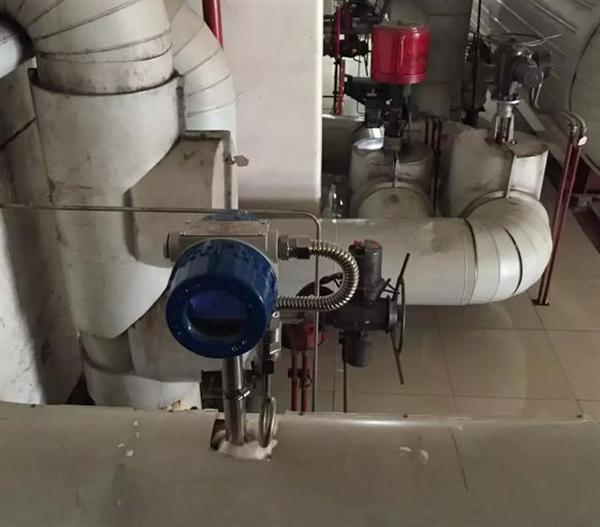What is temperature and pressure compensation?
Temperature and pressure compensation: Temperature and pressure compensation usually refers to the result of measuring the data at a temperature of 25 degrees and a standard atmospheric pressure. Usually the temperature and pressure of the measurement site are different from the standard, so the general instrument can measure the temperature of the site. With the pressure, then the measurement results are automatically compensated by the calculation formula.
Gas vortex flowmeter is a relatively accurate and economical flowmeter in many gas steam flowmeters. 304 (316L) material has a variety of installation methods. Whether the vortex flowmeter needs temperature and temperature compensation depends on the actual needs. If the deviation of the working conditions is not large or the requirements are not high, it is not necessary to perform temperature and pressure compensation. If accurate metering is required, compensation is required. Compensation is generally carried out using on-site installation pressure and temperature sensors, and the pressure, temperature and flow data are uploaded to the PLC for calculation to obtain the standard flow.
For example, the measurement of air flow, the commonly used flowmeter is the volume flow under the current temperature and pressure, but the mass of the air is affected by the temperature and pressure, the calculation formula is: PV=NRT=>m=MPV/RT ideal Gas equation of state, where R is a constant, about 8.314 J / (mol · K); P is the gas pressure, in Pa; M is the molar mass of the substance (or the average molar mass of the mixed gas); V is the volume of the gas, Unit m3; T is the system temperature, unit K. For approximate calculation, the temperature is considered to be 20 ° C (293 K) at room temperature, and the gas approximates an ideal gas.
Air mass m=29g/mol×101325Pa×1m3÷8.314J/(mol·K)÷293.15K=1205.63g=1.2kg It can be seen from the formula that air quality has a great relationship with temperature and pressure, so the instrument should be measured first. The temperature and pressure of the field are measured and then automatically compensated.
There are also specific media to look at in specific measurements:
1. When measuring gas, it needs temperature and pressure to compensate at the same time; gas is generally settled in standard condition volume flow. The flow rate changes as the volume flow rate or pressure of the gas changes.
2. When measuring superheated steam, temperature and pressure are required to be compensated at the same time; steam is generally settled by mass flow. Because of any change in temperature or pressure, the density of the vapor changes and the mass flow changes.
3. When measuring saturated steam, single temperature compensation or single pressure compensation is required. The density of saturated steam has a fixed correspondence with temperature or pressure (saturated steam density meter), and any one of them can determine the density of saturated steam.
4. When measuring liquid, generally no pressure compensation is required. Below 5MPa, generally only the temperature influence is considered, and temperature compensation is required for accurate measurement. In general measurement, no compensation can be used; measuring some hydrocarbons (such as crude oil) generally requires temperature and pressure compensation at the same time.

The advantages of the temperature-compensated gas vapor vortex flowmeter are as follows:
1. The biggest advantage is that the anti-vibration performance is particularly good, there is no zero drift, and the reliability is high.
2. The versatility of the sensor is very strong, so that the sensor has good interchangeability. The surface of the sensor and the vortex generator are processed by advanced numerical control equipment to ensure the processing precision, so that the parts (especially the vortex generator) are universal. Strong, so that it does not affect the repeatability and accuracy of the sensor due to the replacement of components; it can produce a strong and stable vortex signal.
3. In a certain range of Reynolds number, the flow characteristics are not affected by fluid pressure, temperature, viscosity, density, composition, but only related to the shape and size of the vortex generator.
4, the output of the pulse signal or analog signal proportional to the flow, no zero drift, high precision, easy to network with the computer.
5, the structure is simple and firm, no moving parts, high reliability, easy to use and maintain.
6. The detecting component is not in contact with the medium, the performance is stable, and the service life is long. The sensor is installed separately from the vortex generator, and the high temperature resistant piezoelectric crystal is sealed in the detecting probe and is not in contact with the measured medium, so the vortex street The flowmeter has the characteristics of simple structure, good versatility and high stability.
7, the measurement range is wide, the range ratio can reach 1:10.
8. There is no need to compensate when measuring the volume flow. The signal output from the vortex is actually linear with the flow rate, that is, proportional to the volume flow. The purpose of pressure and temperature compensation is to obtain the density of the fluid. Multiply the volume flow to obtain the mass flow. If the volume flow of the gas is measured, no compensation is needed.
Specific requirements can be contacted by Jiangsu Xianda Instrument Co., Ltd. technical staff for your selection.
Ec Backward Centrifugal Fan,Backward Centrifugal Fan,Backward Curved Centrifugal Fan,Backward Inclined Fan
Hangzhou Jinjiu Electric Appliance Co Ltd. , https://www.jinjiufanmotor.com
